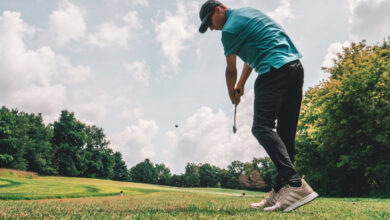Understanding the Basic Physics of Golf: How to Hit the Ball Further
Golf may look simple on the surface, but there’s a bit of science behind that graceful swing. If you’re an amateur golfer looking to add a few extra yards to your drives, grasping some basic physics can help. Let’s break it down into practical tips that will have you smashing those drives down the fairway in no time!
The Importance of Grip and Stance
Before we start getting into the swing mechanics, let’s talk about your grip and stance. Both of these elements are the foundation of your shots. A solid grip ensures you have control over the clubface. Hold the club lightly but firmly, with your fingers wrapped around it and your palms facing each other.
Next, your stance should be shoulder-width apart, with your knees slightly flexed. This stable base helps you maintain balance throughout your swing, which is crucial for transferring energy to the golf ball.
The Role of Swing Speed
Now, let’s get into the physics! One of the main factors determining how far you hit the ball is swing speed. The faster your club moves when it strikes the ball, the further the ball will go — that’s a simple law of physics.
To increase your swing speed, focus on developing your core and upper body strength. Exercises like resistance training, yoga, or Pilates can improve flexibility and strength, allowing for a more powerful swing. Make sure to regularly practise your swing to master that speed. Consistency is key!
Understanding Launch Angle
Have you ever considered the angle at which the ball leaves the club? That’s called the launch angle, and it plays a significant role in distance. For a driver, an optimal launch angle is usually between 10-15 degrees. If the ball is hit too flat, it may not travel far. If it’s launched too high, it could lose momentum.
To achieve the right launch angle, position the ball slightly forward in your stance, around the inside of your left foot (for right-handed golfers). This way, you can strike the ball on the upswing rather than down.
Hitting the Sweet Spot
Every golf club has a “sweet spot,” the area on the clubface that produces the best contact and distance. When you hit the ball with this part of the club, it minimizes energy loss and maximises power transfer.
To find your sweet spot, practise making contact with the ball in different areas of the clubface. You’ll soon get a feel for that ideal hit. The more consistently you find this spot, the better your shots will be!
Follow Through and Balance
The follow-through is just as important as the swing itself. It’s all about balance. After you strike the ball, ensure you complete your swing naturally, facing your target with your chest. A proper follow-through keeps your swing smooth and allows you to maintain that all-important balance, which can increase your overall distance.
Practice Makes Perfect
As with any sport, practice is essential. Consider setting aside some time each week to work specifically on these aspects of your game. Take note of how changes in your grip, stance, and swing impact your distance. You may even want to record yourself to see your progress.
Summary
Hitting the ball further isn’t about brute strength; it’s about understanding and implementing some basic principles of physics combined with good technique. Start by perfecting your grip and stance, increase your swing speed with strength training, focus on the launch angle, hit that sweet spot, and maintain your balance through a proper follow-through.
With time, patience, and a bit of practice using these tips, you’ll soon find yourself driving the ball further down the fairway, impressing your mates on the course. So grab your clubs, head to the range, and let’s get swinging! Happy golfing!




